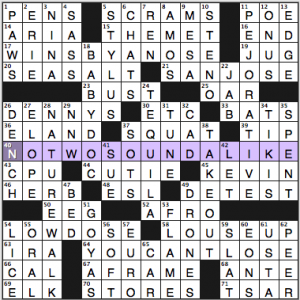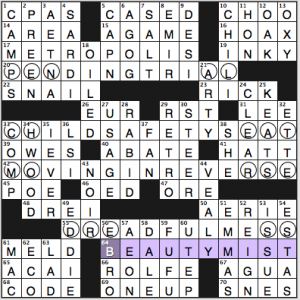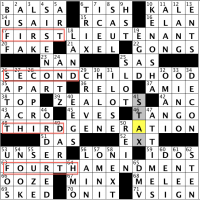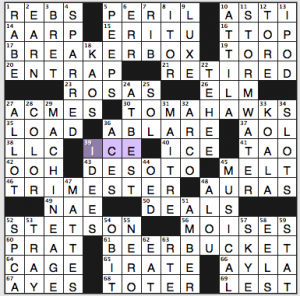Jonesin' 4:12
NYT 3:00
LAT 2:55
CS 4:39 (Dave)
Lynn Lempel’s New York Times crossword
Fresh theme angle: NO TWO SOUND ALIKE is clued as 40a: [What’s odd about the ends of the answers to the four starred clues], and those ends are all words with the letters OSE, pronounced differently each time.
- 17a. [*Triumphs, but barely], WINS BY A NOSE.
- 21a. [*First capital of California], SAN JOSE.
- 54a. [*Nonfatal amount of radiation, say], LOW DOSE.
- 64a. [*Huckster’s pitch], YOU CAN’T LOSE.
Ohs, oh-zay, ose, ooze.
Highlights in the fill include NATURE WALK, BABY DOC Duvalier, TEQUILA, PEJORATIVE, DENNY’S, THE MET, SEA SALT, and LOUSE UP. Good stuff, and it’s only Tuesday. We usually think of Lynn Lempel as the queen of Monday puzzles, but when she takes the theme a notch harder, she can reign over Tuesday too. Nothing too fancy, but nobody is looking for fancy in Monday and Tuesday puzzles. The worst of the fill may be STENO, TSAR, and a few abbrevs, but mostly the fill is straightforward and familiar material. Four stars.
Matt Jones’s Jonesin’ crossword, “Gonna Crack”
This week’s theme is cracked codes—various phrases’ opening and closing letters spell out kinds of codes, and they’re “cracked” by the intervening letters:
- 20a. [Awaiting a court date], PENDING TRIAL. Penal code.
- 33a. [It may have a five-point harness], CHILD SAFETY SEAT. Cheat code (in a video game).
- 42a. [Going way back?], MOVING IN REVERSE. Morse code (-.-. .-. — … … .– — .-. -.. / .–. ..- –.. –.. .-.. .).
- 55a. [Big trouble], DREADFUL MESS. Dress code. A rather contrived phrase, this DREADFUL MESS.
And now, five more things:
- Really? No kidding? The [Old pantyhose brand with a famous Joe Namath ad] is BEAUTYMIST? That doesn’t ring a bell at all. I would have guessed L’eggs or Hanes. Here’s the commercial. Apparently it was indeed a Hanes brand.
- 44d. [Immature, like some meat], VEALY? Gross. (n.b.: I have not knowingly eaten red meat since the ’70s.)
- Never heard of: 36d. [California-based semiconductor company founded in 1981 (hidden in FALSIFY)], LSI. At least the clue gives you the letters, in order.
- 32d. [Suffix after Rock or Raisin], ETTE. Uh, isn’t the candy spelled Raisinets?
- 59d. [___ Berry (Jones Soda flavor)], FUFU. Not ringing a bell. But then, I really never buy Jones Soda.
3.75 stars.
Bruce Venzke’s CrosSynergy/Washington Post crossword, “Gridiron Downs” – Dave Sullivan’s review
Well, no late night emails to Sam on this one; a pretty straightforward theme today. Four phrases start with the ordinals first through fourth.
So I’m wondering what makes these specifically football downs instead of say gears of a car, space-time dimensions or the grades I successfully completed? A fifth entry beginning with TURNOVER, for instance, would give it a decidedly footballish slant. Without something special like that, the theme left me a bit flat.
OK, time to pick my favorite and unfavorite clue and entry. FAVE: [Super gung-ho types] was ZEALOTS. A stellar entry for the central squares. (Paul Lynde would be pleased.) UNFAVE: I have to actually choose a theme entry: [Period of senility] was SECOND CHILDHOOD. I’m all for multiple childhoods, or even never outgrowing your first. Nothing senile about that.
Amy Johnson’s Los Angeles Times crossword
It took me a while to figure out what the theme was, and I was looking at TOMAHAWKS and TRIMESTER too before I noticed that there were just two Across and two Down clues marked with asterisks.
- 17a. [*Protective fuse container], BREAKER BOX.
- 61a. [*Tailgater’s brew chiller], BEER BUCKET.
- 11d. [*Flood control concern], STORM WATER.
- 29d. [*Era of mass production], MACHINE AGE.
- 39a. [With 40-Across and “Baby,” a 1990’s hip-hop hit that answers the question, “What can precede both parts of the answers to starred clues?”], ICE, ICE.
Ergo: icebreaker, icebox, ice beer, ice bucket, ice storm, ice water, ice machine, ice age. Brr! The theme’s as solid as the iceberg that brought down the Titanic. Plus: Vanilla ice dance break!
Elsewhere in the puzzle, here’s what I liked best:
- 28d. [Enjoy crayons], COLOR. Who doesn’t have a fondness for crayons?
- 51d. [Jewelry resin, AMBER. Amber is so cool.
- 5d. [Marshmallowy Easter treats], PEEPS. Fun entry, good in dioramas, disastrous as an edible.
I didn’t love the rest of the fill. Things like TEHEE, ABLARE, ERI TU, and all sorts of other entries that show up far more often in crosswords than in everything else we read.
Four stars for the theme, 2.5 for the fill.




Loved the NYT. Super smooth.
ditto!!
;-)
NYT: Smooth and easy. A simple, albeit brief, pleasure. And the theme is such a true observation about a distinctive feature of the English language. I had to explain this to my husband, a native English speaker, when we first met and he would chuckle at my missteps: The biggest challenge for an ESL type is that you can look at a word and have no clue how it’s pronounced. That is not true in French, for example. While there are many ways to render a sound in French writing (e.g. ai, ei, e with an accent are all variants of the long English “A” sound), if you see a written word, you KNOW how to pronounce it.
I learned most of my English as a teenager from reading books. I did my best to understand the vocab and sentence structure. But when I finally met real English speakers, I realized that I had consistently mispronounced many words in my head. Example: Albeit=”I’ll bite”! And think about rough vs. dough vs. bough. As to where to put the emphasis… Do I work in a laboh ratry or a lab retory? What a challenge!
Unfortunately, that’s not entirely true about French. For example, why do “ville” and “fille” not rhyme? French pronunciation is not nearly as crazy as ours is in English, but it does have its quirks.
True. I stand corrected. May be it’s fairer to say that the percentage of uncertainty is much lower.
Thanks to the Puzzlemaster himself for gracing the comments..!
If you can remember A THOUSAND TRANQUIL CITIES, you’ve got the only French words ending in -ille that are pronounced /luh/ and not /yuh/
MILLE TRANQUILLE VILLE
–Signed, Caleb Stokes’ Opera Coach Who Introduced Himself To You At The 2012 ACPT (aka Wilson Southerland)
Not to mention that if you see the words “fils” or “couvent” out of context you have literally no way of knowing how they’re pronounced.
WOW– a rare comment from WS. He’s right, of course, about “fille” and “ville”, but the “ville” pronunciation is very much the rare exception. The list of words ending in “ille” pronounced with a liquid , rather than a palatalized ‘l’ is very short, and can easily be memorized. “Mille” and “tranquille” are the only ones that come immediately to mind.
Also the French nasals can be a bit unpredictable — ‘en’ is occasionally pronounced as ‘in’, in vin — (e.g. the city Amiens, or the conductor André Cluytens); the ‘in’ sound in ‘vin’ is sometimes spelled ‘ain’ as in bain. Italian is a better illustration of a language where the pronunciation is almost fully determined by the spelling. A few words are stressed irregularly; e.g. occasionally a terminal vowel is irregularly stressed, but this is usually marked by an accent grave (a real one, not the one humorously referred to by WC Fields.)
I have often heard Italians say “When you tell an American your name, he usually asks you how to spell it. But an Italian never asks that. There’s no need to.” But non-native English speakers who have struggled to learn our language often say things to me like — Americans complain about having to learn the gender of foreign words, but for us, learning the pronunciation is at least as arbitrary and tedious as learning genders, where you often have orthographical clues. E.g. bird, curd, herd, heard word, myrrh– illustrations can be multiplied at great length.
Gee, I didn’t see pianoman’s post as I wrote mine. I wonder who he is. (Not me)
Wonder no more: I’m an opera coach/conductor/pianist who’s based in NYC. Thanks for the backup Bruce! I’m a constant reader of, but rare commenter on, this fantastic blog.
I sat 3 seats down from our Blogs-tress at the 2012 ACPT but was too embarrassed to introduce myself to her after my dismal finish on puzzles 2/5. #hiamy!
Aw, you should’ve said hi! I don’t cast aspersions on less speedy solvers. In fact, I like to maximize the slowness of everyone else at the ACPT so that I can finish ahead of as many people as possible.
Even native speakers have difficulties in this regard, as you’ve no doubt observed. My maternal grandfather, a habitual and egregious mispronouncer, would proudly declare that he had a “reader’s vocabulary” and took it as a badge of honor.
And I certainly persist in my pronunciation quirks, some intentional, some not.
Ah, poor Goya. Greatest artist of his generation, but to crossworders he’ll forever be known for “The Naked Maja”. Personally I prefer his later, darker work after he was exposed to the horrors of war. But nudity will always triumph in the end.
He’s in the tippy-top of my favorites. Los Desastres de la Guerra is a brilliant series (saw the show at the Met back in the 90s), as well as his “black” paintings (with the famous depiction of the Titan Saturn). But of course, nearly all of his work is brilliant.
Tangentially, I found this list of unusual color names to be interesting artistically, intellectually, and from a crossword aspect. Take special note of the first entry.
And hey, “The Clothed Maja” is a fine painting too.
“Saturn Devouring His Son”. A most singular work!
YES — and the “Black paintings” generally. Wonderful.
I’d add “The Second of May 1808” and “The Third of May 1808” to the list.
The latter is currently my facebook “cover image,” though I’ll be updating it soon.
When I took Fine Arts in college, my two favorite painters were Goya (the dark period featuring lunatics and Saturn) and Jacob van Ruisdael.
This was a superb Tuesday puzzle.
Pannonica, great color list. Games magazine used to have some great puzzles requiring you to match a word that you perhaps knew with its actual depiction. One of them showed pictures of colors such as saffron, fuchsia, puce, etc. and you had to guess which was which. In another, the puzzle showed a picture of every crossword friendly bird: erne, tern, dodo, auk, etc.
I hope I can finally remember vermilion. The opening three letters always make me think it is green. Ironically, the second color on the link is verdigris, which is green.
Steve
CD Friedrich? JMW Turner?
Thank you. Two great artists. This one looked like something Ruisdael might have painted:
http://en.wikipedia.org/wiki/File:Caspar_David_Friedrich_-_K%C3%BCste_bei_Mondschein.jpg
I forgot I also loved Monet.
Steve
Turner is great. I read somewhere that a lot of his impressionistic landscapes were actually unfinished by his own standards, hence the vague outlines that make us consider him ahead of his time. In any case, a major landscape artist.
How about Vermeer? I used to go to the Rijksmuseum and stare at the 3 they had there for literally half an hour apiece. Surprisingly, this didn’t seem to bother the other museum goers, most of whom were there to see Rembrandt and his Night Watch.
and from a color-analysis/psychological meaning aspect, i also found this article about van gogh’s palette (however you pronounce the artist’s name…) “interesting artistically, intellectually”:
http://www.nytimes.com/2013/04/30/arts/30iht-vangogh30.html?hpw
;-)
Interesting article, and a lot of it made sense to me intuitively. Not sure I had so many of those preconceived notions about van Gogh (I tend to process things empirically, or at least I make an effort to).
Would have benefitted from a slideshow showing the paintings with “corrected” pigments (read: reinfused with red).
seems we’ll have to go the the exhibit for that!
;-)
yes! His early work tends to be court painting, which I understand paid the bills, but there are only so many portraits of rich people celebrating their own greatness that I can stand to look at. His later work is so much more personal, and therefore, to me, ages far better with an emotional impact that still resonates today.
hey, I always thought “vermillion” to have something to do with worms, with that spelling! Not far off, though, with the bodies of dried insects, even though it has a totally different etymology. Didn’t know they called it “Goya”! thanks for sharing.
It doesn’t really bother me, but I was surprised to see LOUSE UP and LICE in the same grid.
Great, now I’ll have “Lice Lice Baby” in my head all day.
LICE is used when you louse something up the second time.
Crossword constructors, ahem, “lice”-ense
Great NYT today, so smooth and fun!
And what a kick to see ICE repeated in the LAT. Excellent day for puzzles!
I think the best part of this puzzle was the commentary, though it was based on the wonderful puzzle and the imagination to construct it. I agree with just about everything that was said. The re-imagined Van Gogh is just that – shown in a video construction.
I still hate to think of LICE on a dog, though Gareth once set me straight that they can infest dogs in certain geographical areas.
Ironically, I needed most of the crossings for it… Here, to my knowledge/experience, all species are asymptomatic. Itchy dog usually = fleabite or other allergy, lupus/pemphigus, mange, ringworm, pyoderma or malassezia (or combinations thereof), none of which fit. It’s a legit clue, it was just supremely unhelpful to me! My favourite dog louse: Heterodoxus spiniger, just cos its name is awesome!
Alas, we can come full circle and point out the various pronunciations of “-ICE” (LICE, LICORICE, BODICE…).
Hey johnfarmer, if you are reading this, thanks for the intro to Ms Lake yesterday. I was feeling crusty in my response yesterday, and I think you were only trying to be helpful. I echo the sentiment about learning. In any case, I definitely wasn’t trying to be a forum troll, but probably came across that way. Peace, my friend.